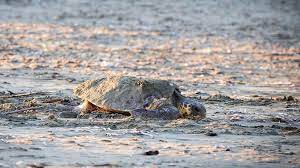
In a remarkable conservation success story, sea turtles are making a significant comeback on the sandy beaches of two British military bases in Cyprus. After years of dedicated efforts to protect these endangered species, the number of turtle nests has surged, signaling a positive step toward the preservation of marine biodiversity in the region. Here’s a closer look at how conservation measures have helped sea turtles thrive on these military bases.
See Here:
The Return of Sea Turtles
Sea turtles, particularly the loggerhead and green turtle species, have returned in large numbers to the beaches of the British Sovereign Base Areas (SBAs) of Akrotiri and Dhekelia in Cyprus. These military bases, though primarily known for their strategic importance, have become unexpected sanctuaries for sea turtles. Recent reports indicate that the number of turtle nests has reached record highs, reflecting the success of conservation efforts on these protected beaches.
Conservation Efforts at the Military Bases
For years, military authorities and environmental groups have worked hand in hand to ensure that the beaches within the SBAs remain safe breeding grounds for sea turtles. The collaboration has involved several key conservation measures, including:
- Beach Monitoring: Conservationists and volunteers patrol the beaches during nesting season to monitor sea turtle activity, protect nests, and ensure hatchlings make it safely to the sea.
- Restricted Access: To minimize human interference, access to the turtle nesting areas is restricted, especially during critical nesting periods. This has significantly reduced disturbances to nesting females and hatchlings.
- Public Awareness Campaigns: Educational campaigns within the military community and surrounding areas have helped raise awareness about the importance of protecting sea turtles and their habitats. These initiatives have fostered greater respect for the natural environment and the need for responsible beach behavior.
Record-Breaking Nesting Numbers
The efforts have paid off. In recent years, the number of sea turtle nests recorded on these beaches has been on the rise. In 2023, environmental groups working in the SBAs reported a record number of nests, with hundreds of hatchlings making their way to the Mediterranean Sea.
The increase in turtle nests is particularly significant because both loggerhead and green turtles are listed as endangered or vulnerable species. Cyprus is one of the most important nesting sites for these turtles in the Mediterranean, and the success on the military bases is a crucial boost to their global population.
Challenges and Threats to Sea Turtles
Despite the positive developments, sea turtles in the Mediterranean face numerous challenges. Threats to their survival include:
- Plastic Pollution: Marine debris, particularly plastic, poses a significant danger to sea turtles, which often mistake plastic for food. Efforts to reduce pollution in the waters around Cyprus are essential to ensure the turtles’ long-term survival.
- Climate Change: Rising sea temperatures and changing weather patterns affect turtle nesting habits and hatchling survival rates. Climate change also leads to sea level rise, which threatens nesting beaches by causing coastal erosion.
- Fishing Practices: Sea turtles are frequently caught as bycatch in fishing nets, a problem that persists across the Mediterranean. Though efforts are underway to introduce turtle-friendly fishing gear, more needs to be done to mitigate this threat.
The Role of Military Bases in Conservation
The presence of British military bases in Cyprus has proven to be an unexpected asset in the fight to protect endangered sea turtles. Unlike many other coastal areas that are heavily developed for tourism or industry, the beaches within the SBAs are relatively undisturbed. This has created a safe haven for sea turtles to nest and for hatchlings to return to the sea.
Military authorities have shown a strong commitment to conservation, balancing their operational duties with environmental responsibilities. Their collaboration with environmental organizations demonstrates how military and ecological priorities can align to benefit endangered species.
Looking Ahead: The Future of Sea Turtle Conservation
The successful resurgence of sea turtles on the British military bases in Cyprus offers hope for broader conservation efforts across the Mediterranean. However, continued vigilance is necessary to sustain these gains. Strengthening protections for nesting beaches, reducing pollution, and promoting sustainable fishing practices are all critical to ensuring that sea turtles continue to thrive.
There is also an ongoing need for public education, as local communities and visitors must remain engaged in efforts to protect these marine creatures. The collaboration between military and environmental groups in Cyprus serves as a model for other regions looking to preserve endangered species while balancing development and conservation needs.
Conclusion
The return of sea turtles to the sandy beaches of two British military bases in Cyprus is a testament to the power of conservation efforts. Thanks to the combined work of military personnel, environmental groups, and volunteers, sea turtles are once again thriving in the Mediterranean. While challenges remain, this success story shows that with the right protections and sustained efforts, endangered species can make a remarkable comeback.





